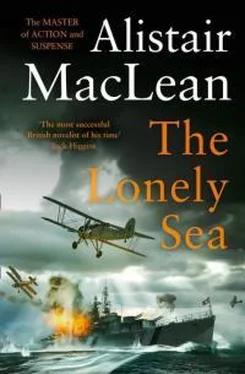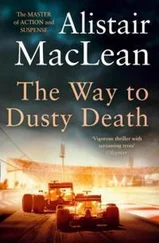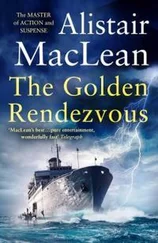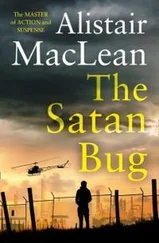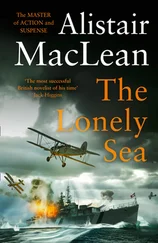It is difficult indeed to understand why the omniscient authorities of the time deemed this murderous wire necessary – did they expect, perhaps, to prevent some of the internees from escaping by diving overboard in mid-Atlantic and swimming for the nearest continent? – but it is not difficult to understand the attitude of Captain Moulton who protested with the utmost violence against the erection of this wire.
‘You are sending men to their deaths,’ he insisted, ‘men who have sailed with me for many years. If anything happens to the ship, that wire will obstruct passage to the boats and rafts. We shall be drowned like rats and the Arandora Star turned into a floating deathtrap.’
But the authorities knew better than the man who had spent a lifetime at sea. The barbed wire remained. And the Arandora Star became a floating deathtrap.
That, then, was the desperate situation that confronted all those who finally managed to struggle to the upper deck. But not all of those who survived the initial impact of the explosion or the lethal onrush of the invading waters reached the upper deck.
There were old men aboard, old men and sick men, and many of these never left their cabins – they had been asleep in their bunks when the torpedo struck, and many of them died there. Others were too weak to fight their way along flooded alleys, or took wrong turnings in the Stygian darkness of the great liner’s vast complex of passageways: Edward Crisp owes his life simply to the fact that he knew the internal geography of the ship like the back of his hand.
Others again did reach the upper decks, found their way to the nearest fore or aft lifeboat blocked by rolls of athwartships barbed wire, and went below again to find some passage which would bring them up to a lifeboat no further away than twenty yards from where they stood. But the press and confusion below decks was increasing steadily, the level of the water was rising, and many of those who went below were never seen again.
Major Bethell, OC of the guard, ordered his men to clear away the barbed wire in front of the lifeboats. (It appears that there was some method of loosening sections of the barbed barricade by operating a slipwire, but no instructions had been given in this.) The guard tore at the wire with rifles and bayonets – Ivor Duxberry has still the scars on his arms as the grim proof of his story – and the rush for the boats was on.
Unfortunately, because of the obstructing wire, trained members of the ship’s company were not able to reach all their boats’ positions – or at least not in time. Edward Crisp and Taffy Williams – the bosun’s mate – arrived at their station to find sixty Germans and Italians already sitting in a lifeboat, and had to order them out – no easy task when everyone was convinced that the Arandora Star was already foundering – before they could begin to lower the boat. Elsewhere, some of the internees tried to lower the boats themselves and within a few minutes, in Duxberry’s graphic phrase, half a dozen of them were hanging on one fall like turkeys outside a poulterer’s shop.
But some of the prisoners of war, as distinct from the internees, proved invaluable. One such was Captain Burfend, master of the Adolph Woermann, who marched a group of men – for the most part highly experienced seamen and confirmed Nazis – in a column of two on to the boatdeck, and lowered several lifeboats in perfect order. Nazis or not, their behaviour was all that could have been wished for at this moment of crisis. Especially was this true of Captain Burfend himself. When he had seen as many men as possible, regardless of race, into the lifeboats for which he had assumed temporary responsibility, he denied himself a place in any of these, stepped back and went down with the Arandora Star.
But though there were not enough lifeboats for all, this was not realized. Most of the intervening barbed wire was still in position, with men flinging themselves bodily upon it, trying to tear it apart with their bare hands, only to find within seconds that they were caught beyond any hope of escape. Others smashed a path through with fire hydrants, went back, incredibly, to collect their suitcases, and returned to find the lifeboats gone.
The survivors, of course, were those who were not caught in or trapped by the barbed wire. Mario Zampi, who had lowered a raft only to have it taken over by some of his fellow countrymen already in the water, dived over the side and all but broke his neck when his lifejacket struck the water. Fulford jumped from the boatdeck – a dive at which even an Olympic champion would have baulked – and struck the water far beneath with such force that large quantities of oil and salt water were forced into his stomach and lungs: he, too, was injured by his lifejacket. Edward Crisp, as said, managed to get away in a lifeboat, while Ivor Duxberry slithered down a rope and landed astride the upturned hull of a lifeboat.
Even as the great liner foundered, there were hundreds still aboard. Most of these were trapped. Some were too terrified to jump. Others, like Captains Moulton and Burfend, elected to remain with the ship rather than abandon it before everyone else had been saved. Few of the regimental guard officers survived. When last seen, they were lined up, as one survivor put it, and chatting amiably like suburban passengers waiting in a morning bus queue. It is difficult to recognize either the wisdom or necessity of this quixotism and nonchalant acceptance of a fate which, until they themselves made the decision, had been by no means certain: but it is impossible not to admire their selfless gallantry.
At 7.30 a.m. the Arandora Star heeled over sharply until she was almost on her side in the water, the guard rails far below the surface of the sea, hesitated for a moment, then, momentarily shrouded in clouds of hissing steam, slid quietly beneath the surface of the Atlantic.
The waters in the immediate vicinity of the foundering liner were alive with people on rafts or clinging to planks or nonswimmers frantically churning the surface of the sea with the last of their rapidly failing strength. All saw what was coming, all struggled fearfully, desperately to avoid it, but for all but a few the effort had come too late, a meaningless tribute to the age-old instinct to survive. How many people were sucked down in the vortex of the plummeting Arandora Star will never be known: but no more, it is certain, than were dragged down, trapped by the impenetrable barrier of barbed wire, or still impaled on the savage hooks, helpless flies trapped in this monstrous spider’s web.
The Arandora Star was gone, but almost a thousand of its passengers, guards and crew – mainly Italians and Germans – still lived, scattered in groups or singly over several square miles of the Atlantic. That morning the Atlantic, mercifully, was calm and all but windless – but the sea was bitterly cold. Before long the number of swimmers and those supported only by planks and benches became pitifully fewer and fewer. Mario Zampi lost all but one of the six companions who originally clung to the same bench as he. Their pathetic cries of ‘Mother’, repeated over and over again in three or four languages, grew fainter and fainter and gradually faded away altogether as the numbing cold struck through the scanty clothing and pathetically limited defences of the old, the infirm and the gravely wounded, and stopped the beating of their hearts. And some there were, supported by their life jackets, who, by and by, just lay face down in the water, dead.
About noon, a Sunderland flying boat appeared and circled the area dropping all it had in the way of first-aid kits, emergency rations, chocolate and cigarettes, and then disappeared to guide the Canadian destroyer St Laurent to the scene.
Читать дальше
Конец ознакомительного отрывка
Купить книгу
